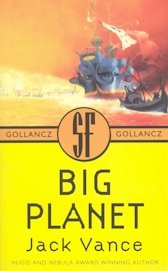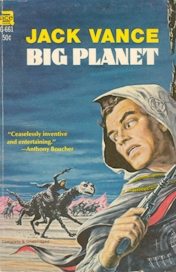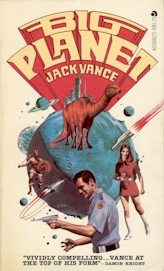
a planetary romance
Gollancz trade paperback
cover art by Jim Burns
218 pages (left)
Ace paperback - 1957 copyright
50¢ cover price
158 pages (right)

Denver Science Fiction & Fantasy Book Club |
 |
Big Planet (1952, 1957, 1978) a planetary romance Gollancz trade paperback cover art by Jim Burns 218 pages (left) Ace paperback - 1957 copyright 50¢ cover price 158 pages (right) |
 |
 |
Another book cover: Big Planet Ace paperback, 1978 cover art by Vincent Di Fate 217 pages (left) |
| Dan | 5 | Amy | 6 |
 |
10 Wow! Don't miss it 8-9 Highly recommended 7 Recommended 5-6 Mild recommendation 3-4 Take your chances 1-2 Below average; skip it 0 Get out the flamethrower! U Unfinishable or unreadable - Skipped or no rating given |
| Cheri | - | Barb | - | ||
| Aaron | 6 | Cynthia | 3 | ||
| Jackie | 5 | Ron | 5 | ||
| Christine | - | Mitch | 3 | ||
| Amelia | - |
|
Aaron's Commentary
Jack Vance - Big Planet
Like most of Vance's work, Big Planet is an imaginative romp across a vividly conceived world, a more sophisticated version of Edgar Rice Burroughs' Mars and Venus planetary romances. Vance uses a fun adventure story to explore the implications of his premise of a huge world where anarchy reigns, a premise he justifies with reasons both physical (the planet is too poor in heavy metals to maintain a high level of technology) and social (the planet was originally populated by Earth's misfits). This concept inspires some terrific imagery, notably the vast "monoline" travelers use to sail over the heads of would-be marauders for thousands of miles. The social issues arising from dealing with this huge low-tech planet are also quite interesting. For the most part, Vance adheres to pulp conventions - Big Planet was originally published in Startling Stories - but he defies the reader's expectations in ways that earlier pulp writers rarely did. In one scene, for example, a character disappears in a seemingly idyllic town, and we are given to believe that something terrible has happened to him. Instead, we finally learn that he has simply chosen to join the town's strange and amusing social system, where all citizens split time as both aristocrats and servants. While I found this novel enjoyable, it has some obvious flaws. The writing is hurried, to the point that one often must reread passages to figure out what is happening, which is especially distracting in the action scenes. The disjointed writing is even more apparent in the expanded version that has appeared since 1978 than in the original 1957 book version. The story is also short on characterization, with only the protagonist Claude Glystra fleshed out at all. The bad guys are devoid of personality, the good guys almost indistinguishable. Worst of all, the leading lady is a weak and unbelievable character, and as a result her romance with Glystra goes nowhere. What do you think? Your comments are welcome. Please send them to vanaaron@excite.com |